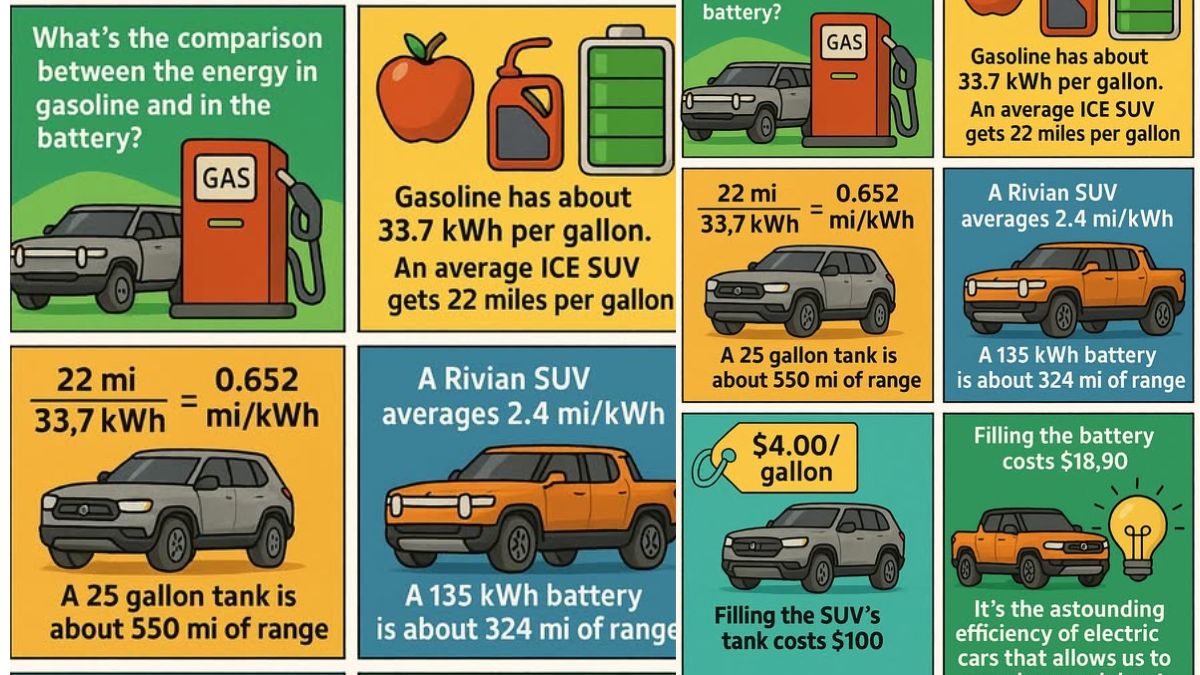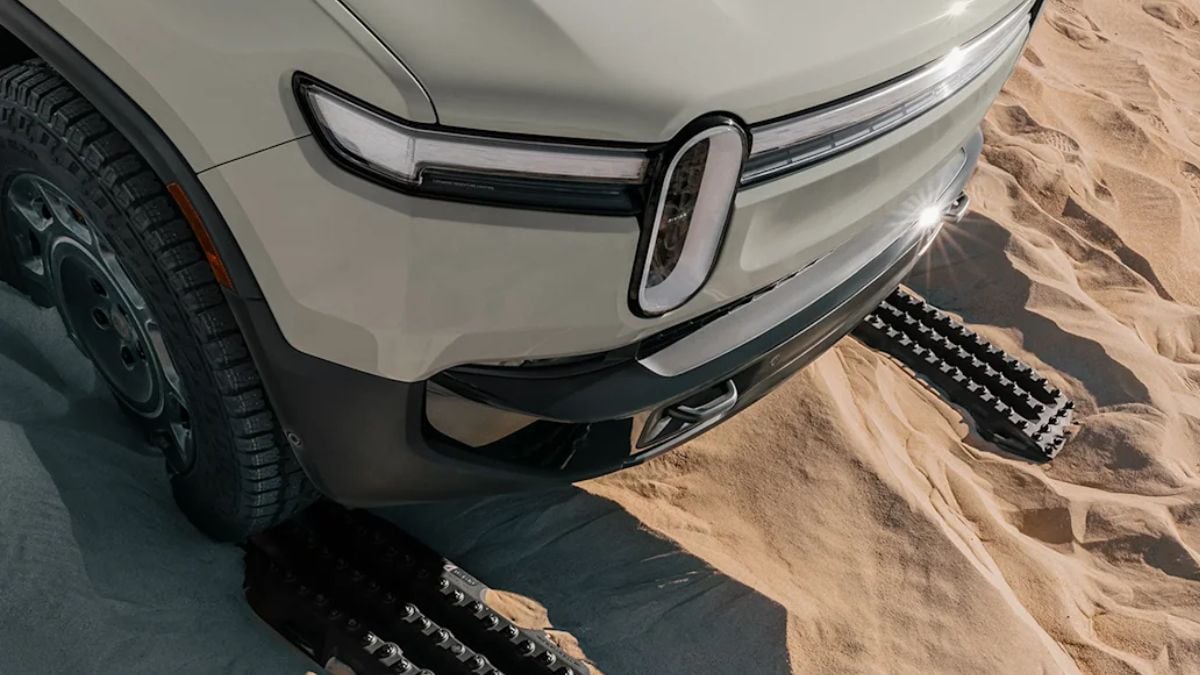This Rivian owner gets just 2.4 mi/kWh, but his cost-per-mile is so low it puts gas SUVs to shame, and his simple math might finally end the EV efficiency debate.
When you drive an electric truck like a Rivian, you get used to the questions. People want to know how far it goes, how long it takes to charge, and, almost every time, how much it actually costs to run. And I get it. On paper, a figure like “2.4 miles per kilowatt-hour” doesn’t sound impressive, especially when small EVs boast numbers twice as high.
But one post I saw recently in a Rivian Facebook group really cut through the noise. Martin Bogomolni, a fellow Rivian owner, decided to settle the debate once and for all by doing something refreshingly simple: making a comparison that anyone can understand. “People have been asking me questions at various Rivian events as to why, despite our Rivian's only getting 2.4 mi/kWh, they are still more efficient than internal combustion trucks/SUVs,” Martin wrote. “To make an apples-to-apples comparison, I've put together an informative diagram. What it comes down to is that despite electricity being more expensive than gasoline in pure terms of $$$/kWh, the Rivian is so much more efficient in using that energy that the savings more than make up for it. TL; DR: SUVs cost $0.18/mi, and the Rivian is just $0.05/mi when you do the apples-to-apples comparison.”
Just five cents per mile. That’s the number that stood out to me. Because I’ve been asked the same thing at chargers, car meets, and even in my own driveway, “is it really cheaper than gas?” According to Martin’s math, yes, and by a lot.
Why 2.4 mi/kWh Isn’t the Whole Story
Let’s zoom out for a second. Sure, 2.4 mi/kWh sounds low if you’re used to Tesla's or Bolts doing 4.0+ mi/kWh. But we’re not talking about compact sedans here. Rivian's are big, capable trucks with off-road tires, dual motors (or even quad), and battery packs built to haul, tow, and climb.
So what really matters isn’t just efficiency in isolation, it’s cost per mile. And when you break it down, that’s where the Rivian shines.
Let’s use Martin’s example. Say you’re paying $0.12 per kWh at home, which is close to the U.S. average. At 2.4 mi/kWh, that’s about 5 cents per mile. Compare that to a gas SUV getting 18 mpg with gas at $3.50 a gallon, that’s about 19 cents per mile.
Even if you’re charging at $0.20/kWh (which some people do on public chargers), you’re still only paying around 8 cents per mile. That’s less than half the cost of gas.
And I’ve written about scenarios where things don’t go perfectly. In this piece, I covered a Rivian owner whose truck failed to charge overnight, despite doing everything right. But even with rare hiccups like that, charging from home remains incredibly affordable, and most importantly, predictable.
The Comments Said What Everyone Was Thinking
Beneath Martin’s post, Rivian owners jumped in with thoughts and questions. One that stood out came from Matt, who added: “This is a great graphic. But, for purposes of truth in advertising, it would be helpful to state what you are using for cost per kilowatt-hour to reach your battery’s ‘fill-up’ cost.”
That’s a great point. The price you pay for electricity makes a big difference in your cost-per-mile math. If you charge at home on a time-of-use plan or solar, you’re golden. But if you’re relying heavily on fast charging, especially in states with high electricity prices, your cost creeps up.
That’s something I explored more deeply in this article about what happens when your full charge only gives you 210 miles. Even when things don’t go exactly as expected, it rarely swings the numbers so much that a gas car becomes cheaper.
But Doesn’t That Efficiency Number Still Look, Bad?
Honestly, I used to think so too. I’d see 2.4 mi/kWh on my trip summary and cringe a little. But that’s before I really understood what’s behind it.
Unlike gasoline engines, which waste most of their energy as heat, EVs convert over 85% of stored electricity into forward motion. Internal combustion? Closer to 25%. So even if a Rivian doesn’t look wildly efficient compared to a sedan, it’s still crushing most gas-powered trucks in terms of energy use.
Plus, EVs don’t “idle” the way gas cars do. Sitting in traffic? You’re barely using any power. Preheating your cabin in the winter? It costs a few cents, not a quarter tank.
 What Real Owners Are Paying
What Real Owners Are Paying
A few owners chimed in on the thread to share their real-world charging costs. One said they spent around $28 to charge from empty to full at home and got about 280 miles out of it. That’s exactly 10 cents per mile. And if you’re not letting your battery run down that far, or if you’re topping off regularly, the cost is often even lower.
I’ve seen stories like this play out over and over again in the Rivian community. Even in less-than-ideal cases, people are still saving. Like the owner who was surprised by a 10% battery drop right after delivery, or another who got hit with a 12V warning that forced a service appointment. These things happen, but they don’t erase the bigger financial picture.
And if you’re wondering whether other EVs are better at fast charging, I compared Rivian’s charging reality in a piece on why I left the Blazer EV for good. Spoiler: Rivian holds its own surprisingly well, especially when you understand how to work with the system.
A Personal Take: The Math Matters, but So Does the Mindset
As someone who writes about cars for a living, I try to stay neutral and data-driven. But I’ll be honest, when I first heard Martin’s number, I was surprised too. Not because I didn’t believe it, but because it was so refreshingly straightforward.
I’ve seen plenty of debates online about whether EVs really save money. But the truth is, if you're comparing a Rivian to another truck, something with a big V8, poor city mileage, and high fill-up costs, there’s no contest. Even when the mi/kWh figure looks modest, the dollars-per-mile math doesn't lie.
It’s like I always tell people who ask if EVs are “worth it”: you have to zoom out. It’s not about looking perfect on paper. It’s about real-world use, and how often you’re stopping at a gas station vs. charging at home while you sleep.
What This Really Teaches Us
- Don’t judge an EV by its mi/kWh alone. Especially not a truck.
- Think in terms of cost per mile, not just specs. Numbers only tell part of the story.
- Use your own charging habits to guide expectations. If you’re home-charging most of the time, you’re likely paying far less than someone who fuels up at gas stations.
- Minor issues don’t erase major advantages. Whether it’s a failed charge session or a battery warning, the cost comparison still leans in EVs’ favor over time.
The Takeaway
Efficiency isn’t just about numbers, it’s about how you use the vehicle. A Rivian might not get 4.0 mi/kWh, but it doesn’t need to. It’s a capable, off-road-ready truck that still costs just a fraction to drive compared to its gas-burning competitors.
Let’s Keep the Conversation Going
What’s the lowest or highest mi/kWh you’ve seen in your Rivian, and how do your energy costs compare to your last gas vehicle?
Have you ever had to explain to someone why your “inefficient” electric truck still saves you money?
Share your story in the comments, I’d love to see how others are crunching the numbers.
Narek Hareyan is a young automotive journalist with experience in a golf cart dealership and an interest in the automotive industry. Follow Narek on X for daily news coverage about cars.
Image source: Martin's Facebook page & Rivian Press Room
Over 3.5 years with my…
Over 3.5 years with my vin5xx R1T I'm averaging exactly 2 m/kwh. I've worked from home during that time too, so it's not highway commuting miles, it's very mixed.





